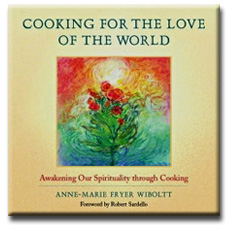|
Comment: this is from Wise Woman. It’s an herbalist site and wonderful to read. Cooking for Love …
|
 |
Whole Grains and Breads
Excerpt from: Cooking for the Love of the World
Awakening Our Spirituality through CookingThe sun-ripened golden grains are the heart of my meals. When prepared well, grains have a delicious, sweet flavor. I carefully pick out any debris before I cook them. Then I wash the whole grains gently by covering them with water.
I run my clean hands through the grains a few times before I strain the water off. I do this until the rinsing water is clear. Afterwards I add the cooking liquid, which most often is plain water. Stocks and spices are fun additions to the cooking liquid only once in a while. For digestibility, I soak the grains in slightly warmed water with an added dash of liquid from natural fermented foods. I use sourdough for bread making. Most often I make whole wheat bread. I make sourdough breads with combinations of rice, oats, millet, rye, barley and corn flour. When using other grains than wheat, I use less flour. The dough is moist, and can be spooned into the baking pans. Well-done bread is sweet and only slightly sour. Yeasted and chemically leavened (baking powder and baking soda) breads are lighter and quicker to make occasionally but no comparison in quality.
Wheat is a flour grain. Hard winter wheat is best for breads and muffins. Softer varieties are better for pasties and durum wheat for noodles and pastas, bulgur and couscous.
Brown rice is a versatile and delicious grain. I can be cooked whole or milled into flour. Short grain brown rice is a harder variety whereas medium and long grain brown rice are lighter and softer. Sweet rice is sticky and more glutinous.
Oat is a cereal of the north. Rich and heartening this nourishing grain lends itself well to warming porridges and soothing creamy soups.
Millet is enjoyed around the world cooked whole but sometimes milled. The common American type is golden yellow whereas many Asian varieties are red.
Rye is a hard, chewy cereal grain cultivated mainly in Europe where it is used in making the delicious sourdough rye bread. In Denmark rye bread is served almost at every meal.
Barley is a hardy cereal grain used in baked goods, soups and porridges. Pearled barley has under-gone a refining process and has been husked and hulled.
Corn comes in many varieties, traditionally cooked with wood ash. Flint corn has hard kernels and matures early. Dent corn has softer kernels than flint corn, matures later and is easier to grind. It is used to make corn meal, polenta and tortillas. Blue corn is similar to yellow flint corn and has a slightly sweeter flavor.
At times I also use teff, quinoa and amaranth native to South Africa, central and South America. They are mainly used whole, prepared with other grains and vegetables. Buckwheat, grown in the cooler parts of the world, is best known roasted as kasha or ground into flour and used in pancakes and noodles.
Crunchy Rice and Wheat Berries with Sesame Salt
Wheat is mainly used in bread making. Soaking and cooking rice and wheat together creates a delicious chewy dish. Sesame salt adds a slight salty and bitter flavor. Pressure cooking brown rice is delicious and strengthening. The grains burst open with sweetness and flavor. Substitute wheat berries with other grains.2 cups short or medium grain brown rice
1/2 cup whole wheat berries
3 1/4 cups warmed water
1 teaspoon vinegar or liquid from cultured foods
2 pinches sea saltRinse the rice and wheat. Soak the grains in the water with vinegar for 8 hours.
Place the grains, soaking water and sea salt in a pressure cooker. Put the lid on tightly and bring the pot to full pressure. Use a flame tamer under the pressure cooker. Reduce heat and maintain pressure for 40 minutes.
Turn off heat and let the pressure come down slowly. Remove the lid and place the rice gently in a serving bowl. Cover with a bamboo mat or cotton towel until ready to serve.
Sesame Salt
1 cup sesame seeds
1 tablespoon sea saltWash the seeds and soak for 5 minutes in water. Drain thoroughly.
Preheat a large skillet. Dry roast the seeds over medium heat until the seeds can be crushed easily between the thumb and ring finger. Keep the seeds moving.
Place the hot seeds and salt in a mortar. Grind the seeds and sea salt together using rhythmical, even circular movements. The sesame salt is done when 90 % of the seeds are crushed. Serve in a separate bowl and store in a tight glass container.
Excerpt from:
Cooking for the Love of the World:
Awakening our Spirituality through Cooking

by Anne-Marie Fryer Wiboltt
A heart-centered, warmth-filled guide to the nurturing art of cooking.
“Cooking delicious nourishing meals – with heart and soul – is easy, fast, and fun with this great guide. Everything you need to know is right here – along with exercises and experiences that will help you love cooking, love yourself,
and love the earth.”
-Susun S. Weed, Author, Healing Wise
Order Cooking For the Love of the World in our Bookshop
